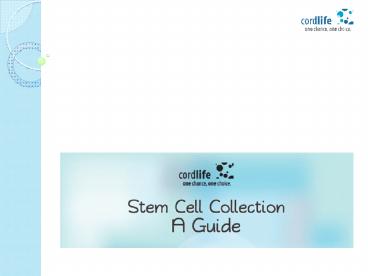Stem cell collection - PowerPoint PPT Presentation
Title:
Stem cell collection
Description:
Stem cells are the undifferentiated cells having a unique capability to transform into any kind of specialized cells. It can differentiate into any type of cell and help to regenerate the tissues or organs of the body. visit, – PowerPoint PPT presentation
Number of Views:157
Title: Stem cell collection
1
(No Transcript)
2
Types of Stem cells
There are 5 type of Stem Cells
- Totipotent Stem cells
- Pluripotent Stem Cells
- Multipotent Stem Cells
- Oligopotent Stem Cells
- Unipotent Stem Cells
3
1. Totipotent Stem cells
- The ability to differentiate into any type of
cell in the body.
4
2. Pluripotent Stem Cells
- Embryonic stem cells and fetal stem cells are 2
types of pluripotent stem cells
5
3. Multipotent Stem Cells
- Have the ability to differentiate into a limited
number of specialized stem cells
6
4. Oligopotent Stem Cells
- Have the ability to differentiate into a just a
few types of cell
7
5. Unipotent Stem Cells
- Have unlimited reproductive capabilities but can
only differentiate into a single type of cell of
tissue
8
How Are Stem Cells Collected?
Stem Cell can be collected in two ways
9
How are stem cells collected?
Autologous Transplant
- An autologous stem cell transplant uses healthy
blood stem cells from your own body to replace
your diseased or damaged bone marrow. An
autologous stem cell transplant is also called an
autologous bone marrow transplant. - Using cells from your own body during your stem
cell transplant offers some advantages over stem
cells from a donor. For example, you don't need
to worry about incompatibility between the
donor's cells and your own cells if you have an
autologous stem cell transplant.
10
How are stem cells collected?
Allogeneic Stem Cell Transplant
- A procedure in which a patient receives healthy
blood-forming cells (stem cells) from a donor to
replace their own stem cells that have been
destroyed by treatment with radiation or high
doses of chemotherapy. In an allogeneic stem cell
transplant, the healthy stem cells may come from
the blood or bone marrow of a related donor who
is not an identical twin of the patient or from
an unrelated donor who is genetically similar to
the patient. An allogeneic stem cell transplant
is most often used to treat blood cancers, such
as leukemia and lymphoma, and certain types of
blood or immune system disorders.
11
Where Can Stem Cells Be Collected From?
Bone Marrow
12
Where Can Stem Cells Be Collected From?
Blood
13
Where Can Stem Cells Be Collected From?
Umbilical Cord
14
Where Can Stem Cells Be Collected From?
Fat Tissue
15
Reference
- https//www.cordlifeindia.com/stem-cell-collection
- cancercenter.com/treatment-options/hematologic-onc
ology/autologus-stem-cell-transplant - lls.org/treatment/types-of-treatment/stem-cell-tra
nsplantation/allogeneic-stem-cell-transplantation - https//www.mayoclinic.org/tests-procedures/auto
logous-stem-cell-transplant/pyc-20384859 - https//www.cancercenter.com/treatment-options/h
ematologic-oncology/autologus-stem-cell-transplant































